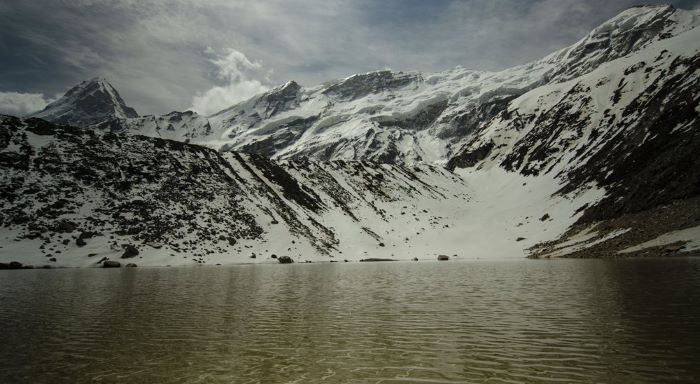
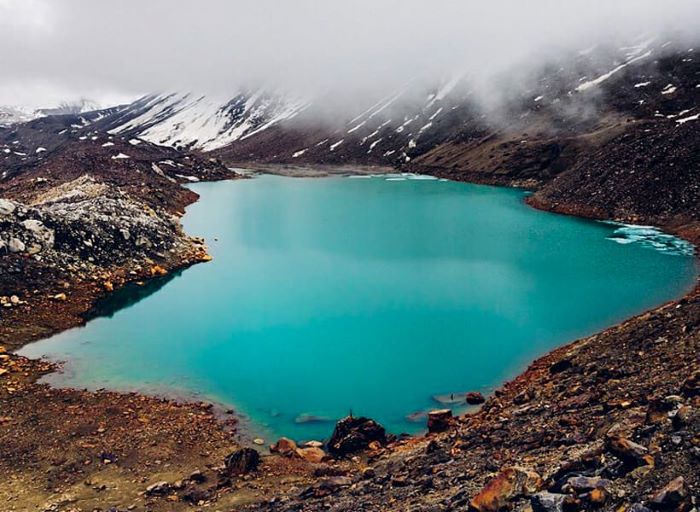
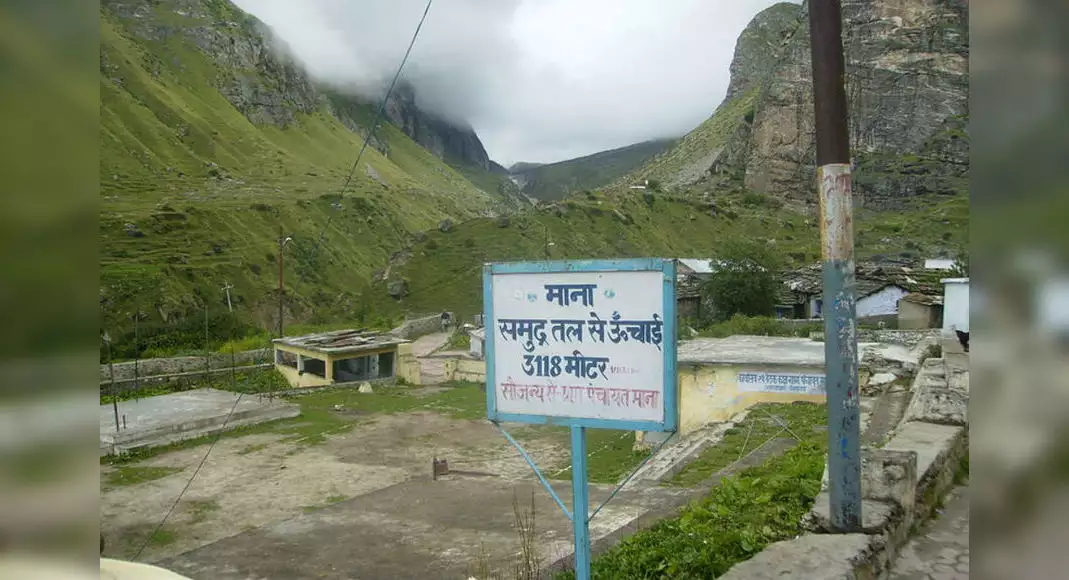
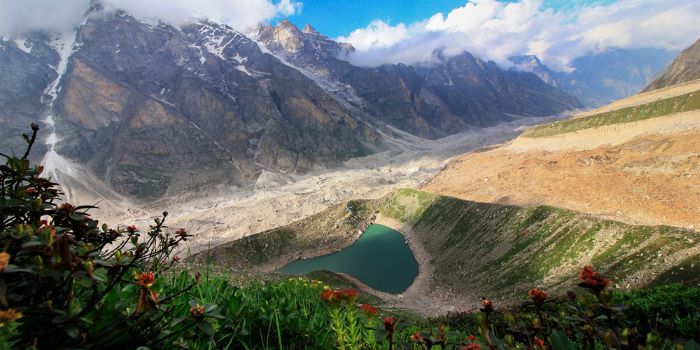
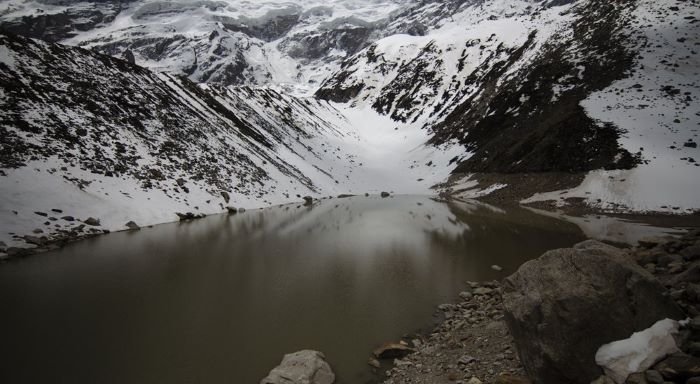
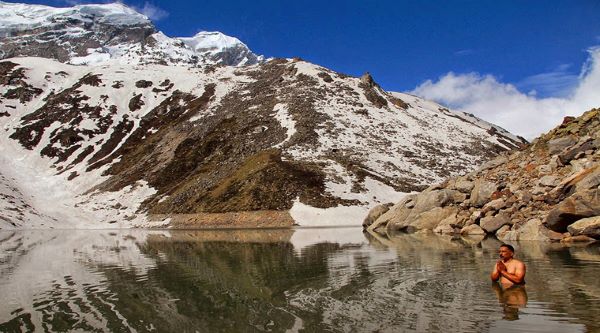
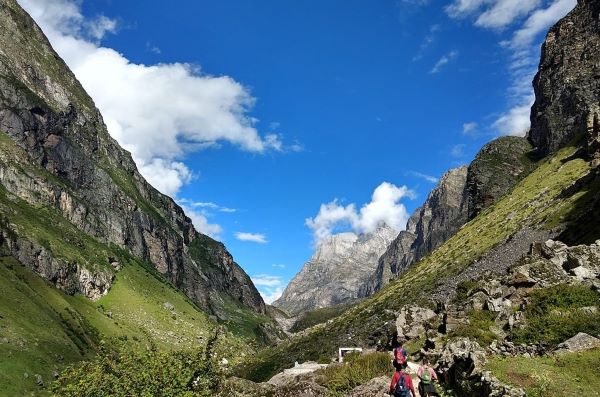
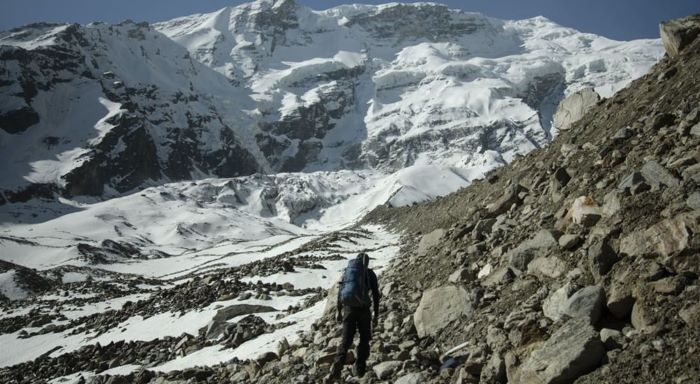
Satopanth Tal Trek
- Breakfast
- Dinner
- Evening Tea / Coffee
- Lunch
- Morning Tea / Coffee
- Public/Private Transport
Please choose a slot below to join a group.
Please choose a slot below to join a group.
Thanks for your Payment!
We have successfully received your payment. Our team will promptly connect with our partners to confirm your booking within the next 24 hours. Typically, this process takes less than 1 hour. Thank you for your patience and trust in our services.
About Satopanth Tal Trek
Satopanth Tal Trek is a high-altitude trek in the Indian state of Uttarakhand, known for its stunning views of snow-capped peaks, glacial lakes, and alpine meadows. This challenging trek takes you to an altitude of 4,600 meters, passing through the sacred Satopanth Lake and the majestic Swargarohini peak. Discover the beauty of the Himalayas and challenge yourself with the Satopanth Trek.
About Satopanth Tal Trek
Satopanth Lake, nestled in the Indian state of Uttarakhand, stands as a pristine glacial lake perched at an impressive altitude of approximately 4,600 meters (15,092 feet) above sea level. This stunning body of water finds its sanctuary amidst the grandeur of the Himalayas, specifically within the boundaries of the Chamoli district. The lake is ensconced by a majestic amphitheatre of snow-clad peaks, including the formidable Satopanth Peak, the regal Balakun Peak, and the ethereal Swargarohini, creating a breathtaking natural spectacle.
Uttarakhand, a northern state of India, is well-known for its picturesque landscape and adventurous trekking routes. One of the most popular trekking routes in Uttarakhand is the Satopanth Tal Trek, which is a hidden gem for nature lovers and adventure seekers. The trek starts from Mana village, the First village of India on the Indo-China border, and takes you on a journey through lush green meadows, dense forests, and snow-covered peaks to finally reach the breathtaking Satopanth Lake.
The trek to Satopanth Lake starts from Mana village, which is around 3 km from Badrinath, one of the most famous pilgrimage sites for Hindus. Mana village is surrounded by towering mountains and is a gateway to some of the most beautiful treks in Uttarakhand. From Mana village, the trek leads to the beautiful Vasudhara Falls, which is a sight to behold. The water cascades down from a height of around 400 feet, surrounded by greenery and snow-capped peaks.
After crossing Vasudhara Falls, the trek leads to the lush green meadows of Laxmivan. The meadows are surrounded by beautiful flowers and offer a stunning view of the surrounding mountains. From Laxmivan, the trek takes you through the dense forests of Chakratirth, which is home to a variety of flora and fauna. The trail is steep and challenging, but the view of the surrounding mountains makes it all worth it.
As you reach the end of the forest, the trail opens up to a beautiful glacier called Satopanth. The glacier is around 14 km long and is a sight to behold. The trail leads to the top of the glacier, where you can see the beautiful Satopanth Lake. The lake is located at an altitude of around 15,100 feet and is surrounded by snow-covered peaks. The lake is believed to be the meeting point of Lord Brahma, Vishnu, and Mahesh, according to Hindu mythology.
Location: District Chamoli, Uttarakhand, India.
Satopanth Trek Distance: 10 km
Trek Altitude: 4,600 metres (15,100 feet)
Trek Difficulty: Moderate to Difficult
Nearest Airport: Jolly Grant Airport, Dehradun
Nearest Railway Station: Rishikesh
Key Highlights of Satopanth Lake Trek
| Duration | 6 days & 5 Nights from Rishikesh to Rishikesh (Kindly allocate an extra day in your schedule to account for acclimatization and potential weather conditions.) |
| Trek Start and End Point | Mana Village (the first village on the Indo-Tibetan border) |
| Trek Type | Trails, steep at points, frozen rivers, forest |
| Temperature at Trek | Extremely cold (maximum 5°C on Monday night, min. -13°C on Monday night). |
| Altitude of Satopanth: | 4600m (15,100 ft) |
| Trek Weather | The Satopanth Lake remains blanketed in heavy snow from the end of September until mid-May, and occasionally even until the end of June. During the summer season, the average daytime temperature hovers around 12 °C, while the nighttime temperatures range from 7 °C to -5 °C. In contrast, winter temperatures can plummet to as low as -25 °C during the day and -36 °C during the night. |
| Best Time: | The optimal period for embarking on a trek to Satopanth Lake is from July to September. |
| Trek Level: | Moderate to Difficult |
| Trek distance: | 10 kilometres |
| Trek Group Size: | A minimum group size of 7 people and a maximum of 30 or More people. |
| Trek Fee | ₹ 20,999 per person |
| Items included | Vehicle (Rishikesh to Rishikesh), Accommodation (Mana & Trek Route), Food (Basic Breakfast & Dinner), A Trek Guide |
The Best Package for Satopanth Trek
- Rishikesh to Rishikesh (7 Days & 6 Nights)We start our journey from Rishikesh, which is well-known as a holy place in Uttarakhand. Our pilgrim Route will be Rishikesh – Mana Village – LaxmiVan – Satopanth – Mana – Rishikesh.
Packages start at ₹ 20,999 Per Person (Including accommodation, meal, and transport) + 5% GST - If anyone is interested in booking a private tour for their friends and family, we have a distinct procedure in place to accommodate your needs.
The Hindu Mythology of Satopanth Lake
According to Hindu mythology, Satopanth Tal trek is believed to be the meeting point of Lord Brahma, Lord Vishnu, and Lord Shiva. Legend has it that Lord Brahma created this lake as a place for penance and meditation. Lord Vishnu is said to have bathed in the waters of the lake to get rid of his sins. Lord Shiva is also believed to have meditated near the lake, and it is said that the divine trinity meets at the lake on the day of the Ekadashi during the Hindu month of Jyeshtha.
Another interesting legend associated with Satopanth Lake is that of the Pandavas, the protagonists of the Hindu epic Mahabharata. It is believed that after the Kurukshetra war, the Pandavas went on a pilgrimage to find salvation for their sins. On their journey, they came across Satopanth Lake trek and decided to take a dip in its holy waters. However, as they entered the lake one by one, only Yudhishthira, the eldest of the Pandavas, was able to complete the dip. The other Pandavas failed the test, as they still had some attachment to worldly possessions. Yudhishthira was then granted salvation, while the other Pandavas had to continue their pilgrimage.
The Satopanth Lake is also considered to be a sacred place for Hindu devotees, who visit the lake to seek blessings and offer prayers. The lake is surrounded by snow-capped mountains and has crystal-clear water, which adds to its spiritual significance.
The Best Time for Satopanth Lake Trek
The best time to undertake the Satopanth Tal trek is from May to June and from September to October. During these months, the weather is generally pleasant, with clear skies and moderate temperatures. The monsoon season, which occurs from July to August, is not recommended for trekking due to heavy rainfall and the risk of landslides. winter months from November to April are also not suitable for trekking, as the trail is covered in snow and the weather can be extremely harsh. Therefore, it is recommended to plan your Satopanth trek during the months of May–June or September–October for the best experience.
How to reach Satopanth Tal Trek
To reach Satopanth Tal trek, a beautiful high-altitude lake located in the Uttarakhand region of India, you will need to follow a multi-day trekking route. The lake is situated at an altitude of approximately 4,600 meters (15,100 feet) and is considered sacred by both Hindus and Buddhists. Here’s a step-by-step guide on how to reach Satopanth Lake:
By Road
From Delhi
Start your journey from Delhi and head towards Haridwar or Rishikesh via NH58.
Haridwar/Rishikesh: From Haridwar or Rishikesh, proceed towards Joshimath (250 km) via NH7.
Joshimath to Mana
Continue from Joshimath to Mana village(45 km), the last motorable point on this route.
Trekking Start Point
The trek to Satopanth starts from Mana village.
By Train
Rishikesh Railway Station: Rishikesh is the nearest railway station to Satopanth. From Rishikesh, you can hire a taxi or board a bus to reach Joshimath (247 km).
Haridwar Railway Station: Alternatively, you can reach Haridwar railway station (280 km) and then proceed towards Joshimath.
Joshimath to Mana: From Joshimath, continue your journey towards Mana village, the starting point of the trek.
By Air
Jolly Grant Airport, Dehradun: Jolly Grant Airport is the nearest airport to Satopanth. From here, you can hire a taxi or board a bus to reach Joshimath (264 km) via Rishikesh or Haridwar.
Helicopter Service
Some tour operators also offer helicopter services from Dehradun to Joshimath, which can shorten your travel time significantly.
Satopanth Trek is a thrilling adventure amidst the breathtaking landscapes of the Himalayas. Whether you choose to travel by road, train, or air, each mode of transport offers its own unique experience, leading you to the starting point of this unforgettable trek.
Accommodation and Meals on Satopanth Trek
The Satopanth Tal trek is known for its breathtaking views of the Himalayan mountains and the crystal-clear lake at the summit. However, it is important to note that there are no hotels or restaurants on the trek, so visitors must bring their own accommodations and meals.
For accommodation, trekkers are required to carry their own camping gear, including tents, sleeping bags, and sleeping pads. It is essential to choose lightweight and durable camping equipment that can withstand the harsh weather conditions on the trek. The campsite options are limited, and trekkers must obtain permission from the forest department before setting up camp. Therefore, it is recommended to plan the camping arrangements in advance to avoid any inconvenience.
In terms of meals, it is advisable to carry a sufficient supply of non-perishable food items that are easy to prepare and provide adequate nutrition. Some popular options include instant noodles, canned food, energy bars, and dried fruits. Trekkers can also carry water purification tablets or filters to ensure that they have access to safe drinking water.
The Places you will see on the Satopanth trek
The Satopanth Tal / Lake Trek is a beautiful and challenging trek that takes you through some of the most stunning landscapes in the Indian Himalayas. Here are some of the must-see places on this trek:
Mana Village
The trek starts from Mana Village, which is the last village on the Indian side before the Tibet border. This picturesque village is situated at an altitude of 3,200 meters and is surrounded by the Himalayan ranges.
Vasudhara Falls
After leaving Mana Village, you will trek for about 6 km to reach the Vasudhara Falls. This waterfall is about 400 feet high and is a popular spot for trekkers to take a break and enjoy the beautiful scenery.
Laxmi Van
The next stop on the trek is Laxmi Van, which is a small meadow situated at an altitude of 3,400 meters. This place offers stunning views of the surrounding mountains and is a perfect spot to set up camp for the night.
Chakratirtha
After leaving Laxmivan, you will trek for about 5 kilometres to reach Chakratirtha. This place is situated at an altitude of 4,000 meters and is known for its crystal-clear water streams.
Satopanth Lake
The final destination of the trek is Satopanth Lake, which is situated at an altitude of 4,600 meters. This pristine lake is surrounded by snow-capped peaks and is considered a sacred place by the locals. The lake is also believed to be the meeting point of Lord Brahma, Lord Vishnu, and Lord Shiva.
Why you should plan the Satopanth Tal Trek
Satopanth Lake is a glacial lake situated at an altitude of 4,600 meters. The trek to Satopanth Lake is not for the faint-hearted, as it is a challenging 6-day trek that requires a good level of fitness and experience. However, the trek is worth the effort as it provides breathtaking views of the Himalayan range, and the pristine blue waters of the lake are a sight to behold. Here are some reasons why you should plan a Satopanth Lake Trek:
Breathtaking Views
The trek to Satopanth Lake trek takes you through some of the most stunning landscapes in the Himalayas. From dense forests and lush meadows to snow-covered peaks and glaciers, the trek provides a feast for the eyes. The views of the Chaukhamba, Neelkanth, and Balakun peaks from the lake are especially stunning.
Wildlife Sightings
The Satopanth Tal Trek takes you through the Nanda Devi Biosphere Reserve, which is home to a variety of wildlife such as Himalayan black bears, snow leopards, musk deer, and blue sheep. The trek also provides an opportunity to spot various species of birds, such as Himalayan monals, snow partridges, and Himalayan griffons.
Spiritual Significance
Satopanth Tal trek is considered a sacred lake by the locals, and it is believed that Lord Brahma, Lord Vishnu, and Lord Shiva take a dip in the lake on a particular day every year. The trek takes you through several pilgrimage sites, such as Badrinath, Mana Village, and Vyas Gufa, which are of great spiritual significance.
Adventure and Challenge
The Satopanth Lake Trek is a challenging trek that requires a good level of fitness and experience. The trek involves steep ascents, descents, and crossings of glaciers and streams. However, the feeling of accomplishment and satisfaction that comes with completing the trek is unmatched.
Cultural Immersion
The trek takes you through several remote villages where you can interact with the locals and learn about their way of life. The region is home to the Bhotiya and Garhwal communities, and you can experience their unique culture and traditions.
Camping
Camping is an essential part of the Satopanth Lake Trek. You will be camping in some of the most picturesque locations, with stunning views of the Himalayas. The campsites are usually set up near rivers and streams, providing a peaceful and serene atmosphere.
Photography
The Satopanth Tal Trek offers plenty of opportunities for photography. From the snow-capped peaks of the Himalayas to the lush green valleys, the region is filled with natural beauty that is perfect for capturing some stunning photographs.
Yoga and Meditation
The serene environment of the Satopanth Trek is perfect for yoga and meditation. You can practice yoga and meditation in the morning or evening, surrounded by the natural beauty of the region.
Stargazing
The clear night skies of the Satopanth Trek provide a perfect opportunity for stargazing. You can witness the Milky Way and other constellations in all their glory.
The Satopanth Tal Trek is an adventure that provides a perfect blend of nature, spirituality, and culture. The trek is challenging but rewarding, and the breathtaking views and wildlife sightings are a once-in-a-lifetime experience. So, pack your bags, put on your trekking shoes, and embark on a journey of a lifetime.
Conquering the Heights: A Journey to Satopanth Tal
In conclusion, the Satopanth Trek stands as a testament to the allure and majesty of the Himalayas. As trekkers traverse through rugged terrain, dense forests, and pristine meadows, they embark on a soul-stirring adventure unlike any other. The journey to Satopanth Tal is not merely about reaching a destination but about embracing the challenges, discovering inner strength, and connecting with the raw beauty of nature. It’s a pilgrimage of the spirit, where each step taken brings trekkers closer to the serenity and grandeur of this sacred Himalayan jewel. With every vista that unfolds and every obstacle overcome, the Satopanth Trek leaves an indelible mark on the hearts and minds of those who dare to tread its path.
Itinerary
-
Day 1- Drive Rishikesh to Mana (3,200 feet)
Start your journey from Rishikesh early in the morning. Drive to Joshimath, a picturesque town nestled in the Chamoli district. En route, you'll pass through Devprayag, Rudraprayag, and Karnaprayag, where the Alaknanda and Bhagirathi rivers merge. Upon reaching Joshimath, take a short break and explore the town. Continue your drive to Mana, the last village, before the trek begins. Overnight stay in Mana.
-
Day 2- Trek Mana to Laxmi Van (9,200 feet)
After breakfast, start your trek from Mana. The trail gradually ascends through beautiful meadows, dense forests, and picturesque landscapes. You'll pass through the Vasudhara Falls, a magnificent waterfall, en route. Reach Laxmi Van and set up camp for the night. Enjoy the serene surroundings and the breathtaking views of the Himalayas. Overnight camping at Laxmi Van.
-
Day 3- Trek Laxmi Van to Chakratirtha (12,100 feet)
Today's trek takes you through some challenging terrain. Begin early in the morning and trek through steep trails and rocky terrain. Pass through the mysterious and enchanting Bheem Pul, a natural rock bridge. Continue your ascent to reach Chakratirtha, a scenic spot with a high altitude lake. Camp at Chakratirtha for the night. Enjoy the panoramic views of the surrounding peaks, including Neelkanth and Balakun.
-
Day 4- Trek Chakratirtha to Satopanth Tal (14,000 feet) and back to Chakratirtha
Start your day with a steep climb to Satopanth Tal, the highlight of the trek. Satopanth Tal is a glacial lake known for its pristine beauty and religious significance. Take some time to admire the tranquillity of the lake and the snow-capped peaks reflecting in its crystal-clear waters. Descend back to Chakratirtha for an overnight stay. Enjoy the starry night sky and the peaceful atmosphere.
-
Day 5- Trek Back Chakratirtha to Laxmi Van
Begin your descent from Chakratirtha back to Laxmi Van. Take your time to soak up the beautiful surroundings and enjoy the natural wonders of the region. Set up camp at Laxmi Van and spend the night amidst the serene environment.
-
Day 6- Laxmi Van to Mana and drive to Badrinath (10,170 feet)
On the final day of the trek, trek back to Mana. From Mana, take a short drive to Badrinath, one of the most revered pilgrimage sites in India. Visit the Badrinath Temple, dedicated to Lord Vishnu, and seek blessings. Explore the sacred town and its surroundings. Overnight stay in Badrinath.
-
Day 7- Badrinath to Rishikesh
After breakfast, bid farewell to the stunning Himalayas and start your journey back to Rishikesh. Enjoy the scenic drive, reflecting on the memories of your adventure. Reach Rishikesh by evening and conclude your trek with unforgettable memories.
Route Map
Satopanth Tal Trek FAQs
Q.1 How difficult is the Satopanth Tal Trek?
- The Satopanth Lake Trek is considered as a moderate to difficult trek. It requires a good level of fitness and prior trekking experience is recommended. The trail is steep and rocky in some sections, and altitude sickness can be a concern.
Q.2 What is the best time to trek to Satopanth Lake?
- A: The best time to trek to Satopanth Lake is between May and October. During this time, the weather is clear and the trail is free of snow.
Q.3 How long is the trek to Satopanth Tal?
- The trek to Satopanth Tal is approximately 16km each way, taking about 3-4 days to complete.
Q.4 What kind of accommodations are available on the trek?
- A: Accommodations on the trek are basic and consist of tents or bunk beds in guesthouses. There are also camping sites available for those who prefer to bring their own camping equipment.
Q.5 Can I hire a guide for the trek?
- A: Yes, it is recommended to hire a local guide for the trek. They are well-versed in the trail and can help you navigate through the difficult sections. They can also provide helpful tips and information about the area.
Q.6 Is it necessary to bring my own camping equipment?
- A: No, it is not necessary to bring your own camping equipment. Guesthouses and camping sites are available throughout the trek. However, if you prefer to bring your own camping equipment, you can do so.
Q.7 Are there any restrictions on the trek?
- A: Yes, there are certain restrictions on the trek. Trekkers are required to obtain a permit from the local authorities before starting the trek. They are also required to follow the rules and regulations set by the authorities in order to protect the environment and preserve the natural beauty of the area.
Q.8 What should I pack for the trek?
- A: Essential items to pack for the trek include warm clothing, good hiking boots, a warm sleeping bag, a backpack, a first aid kit, and adequate amounts of food and water. A water filter or purification tablets are also recommended as drinking water is not always readily available.
I recently completed the Satopanth Lake trek organized by FirstTrek Company, and I must say it was an incredible experience from start to finish. The company's attention to detail and excellent organization made the entire journey seamless. The trek itself was breathtaking, with stunning landscapes, snow-capped peaks, and the pristine Satopanth Lake itself. The knowledgeable and experienced guides provided us with valuable insights about the region's flora, fauna, and local culture. The camping arrangements were comfortable, and the food provided was delicious and nutritious. I highly recommend FirstTrek for anyone looking to embark on an unforgettable adventure.
FirstTrek Company truly exceeded my expectations with their Satopanth Lake trek. From the moment I made my booking, their team was responsive and helpful, providing all the necessary information and guidance. The trek itself was an absolute delight. The trail was well-maintained, and the guides were not only skilled but also friendly and supportive throughout the journey. They ensured everyone's safety and comfort, making the trek accessible even for beginners. The sight of Satopanth Lake was a reward in itself, with its crystal-clear waters and majestic surroundings. Kudos to FirstTrek for creating such a memorable experience
I can't thank FirstTrek Company enough for organizing the Satopanth Lake trek. The entire experience was flawlessly executed, making it a truly remarkable journey. The trek was well-paced, allowing us to acclimatize properly and enjoy the stunning vistas along the way. The guides were knowledgeable and passionate, sharing their insights about the local culture, history, and the surrounding Himalayan ecosystem. The campsite locations were picturesque, and the tents were comfortable and well-maintained. The highlight, of course, was reaching Satopanth Lake, a hidden gem nestled amidst the mountains. FirstTrek Company's professionalism and commitment to customer satisfaction are truly commendable
I recently embarked on the Satopanth Lake trek organized by FirstTrek Company, and it was undoubtedly one of the best adventures of my life. The company's professionalism and attention to detail were commendable. They took care of everything, from permits to accommodations, allowing me to fully immerse myself in the beauty of the trek. The trek itself was challenging yet rewarding, offering breathtaking views of snow-clad peaks, lush green meadows, and the awe-inspiring Satopanth Lake. The team of guides and porters provided constant support, ensuring our safety and making the journey enjoyable. FirstTrek Company is highly recommended for their exceptional service and commitment to creating unforgettable experiences.
FirstTrek Company provided an exceptional trekking experience during the Satopanth Lake trek. Their attention to detail and customer service were outstanding. The guides were experienced mountaineers who made the journey both safe and enjoyable. They went above and beyond to ensure that everyone in the group had a memorable time. The trail was challenging but rewarding, taking us through diverse landscapes and offering panoramic views of the Himalayas. The highlight of the trek was undoubtedly the breathtaking Satopanth Lake, a place of tranquility and natural beauty. I highly recommend FirstTrek Company for their professionalism, expertise, and passion for creating extraordinary adventures.